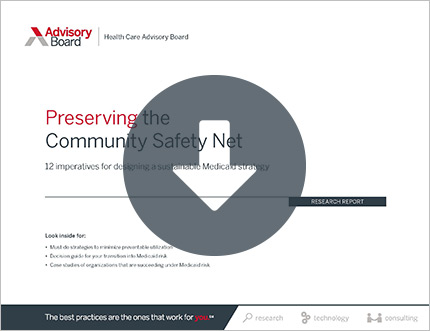Auto logout in seconds.
Continue LogoutBy Ashley Fuoco Antonelli, Contributing Editor
The Trump administration made waves last month when the Department of Justice (DOJ) changed its legal stance on the Affordable Care Act (ACA) and called on the 5th U.S. Circuit Court of Appeals to strike down the entire law as unconstitutional.
While the move came as shock to many observers, President Trump repeatedly has criticized the ACA for being "too expensive." Shortly after taking office he challenged Republican lawmakers to come up with a plan to replace the ACA, and when those efforts failed his administration took somewhat controversial steps to lower ACA spending and increase the number of lower-cost health plans available on the market.
And while many legal experts have said DOJ's new stance is unlikely to affect the way the court rules, the shift did re-spark concerns about what could happen if case ultimately does bring down the ACA.
One source of uncertainty is that lawmakers are sharply divided on any potential ACA replacement. President Trump in interviews has said Republicans would develop a plan if the law were overturned, but GOP congressional leaders have said those talks are unlikely to start before the 2020 presidential election. Democrats, for their part, are rallying around so-called "Medicare-for-All" plans, but there are at least four different iterations floating around, and none have a chance of becoming law while Republicans control the White House and Senate.
So what happens if the ACA falls and no replacement is ready? Below we round up of some of the biggest implications.
1. Up to 12M individuals could lose Medicaid coverage
The ACA's Medicaid expansion allowed states to expand their programs to adults with incomes up to 138% of the federal poverty level (FPL), about $17,236 for an individual in 2019. The federal government picks up the majority of the tab for new enrollees, paying states for 90% of the costs of Medicaid expansion on top of the traditional federal matching rate of 50 to 75%.
In total, 12 million U.S. residents were enrolled under Medicaid expansion in FY 2017, the latest year for which data are available—and those numbers could be even higher today, as Virginia has since expanded its Medicaid program.
If the ACA were repealed, the federal government would no longer be obligated to cover those expansion costs, and without that extra funding, experts have predicted most states would roll back their eligibility thresholds.
2. Up to 11.4M people could lose exchange coverage
The ACA also established health insurance exchanges and allocated money for federal subsidies to help individuals purchase coverage. For the 2019 coverage period, 11.4 million U.S. residents signed up for a federal or state-based exchange plan, of whom 87% qualified for federal subsidies to lower the cost of coverage. According to the latest HHS data, subsidies on average covered $469 of a $612 monthly premium.
Without those subsidies, many of the current exchange enrollees would not be able to afford a comprehensive health plan, and many could become uninsured, the New York Times' Reed Abelson, Abby Goodnough, and Robert Pear predict.
3. Up to 2M young adults and 133M US residents with pre-existing conditions could lose coverage
The ACA also contained provisions that consistently have garnered wide public support and expanded coverage to two key populations:
- Young adults, who are less likely to purchase their own coverage but, because they're typically healthy, are essential to establishing a balanced risk pool; and
- Individuals with pre-existing conditions, who prior to the ACA could be denied or priced out of coverage because of their medical background.
The latest federal data suggest 2.3 million young adults between ages 18 and 26 were able to remain on their parents' health plans under the ACA between 2010 and 2013. Without the ACA, insurers would no longer be required to keep those young adults on their parents' plans.
In addition, the ACA for the first time prohibited insurers from denying individuals coverage because of a pre-existing medical condition, and from charging them more for coverage because of those conditions. HHS' Office of the Assistant Secretary for Planning and Evaluation in 2017 estimated between 61 million and 133 million U.S. residents have a pre-existing medical condition that could have disqualified them from purchasing individual coverage before the ACA.
4. 171M US residents could face high out-of-pocket costs—and skimpier health plans
A ruling striking down the law also could eliminate caps on how much individuals must pay out-of-pocket for coverage and change the types of care insurers—including Medicare insurers—must cover without cost-sharing requirements.
Under the ACA, insurers are required to cover 10 essential health benefits, and the law set a limit on how much consumers pay out-of-pocket for covered services, not including premiums. For 2019, IRS under the law capped out-of-pocket costs at $7,900 for individual coverage and $15,800 for family coverage. Those caps apply to both the estimated 15.2 million individuals who purchase plans in the individual market—including the 11.4 million who purchase coverage on the exchanges—as well as the estimated 156 million individuals who get their insurance through an employer. A ruling striking down the ACA would eliminate those caps, meaning more insured patients could be at risk of bankruptcy.
Further, eliminating the ACA would mean insurers could sell less comprehensive plans that do not cover all of the ACA's essential health benefits. While Republicans argue that such a change could reduce premiums, many health experts have said that less-comprehensive coverage places individuals at greater risk of financial ruin if they suffer an accident or get sick.
5. Uncompensated care costs could rise by $6B—particularly in Medicaid expansion states
Health care policy experts often note that the United States' uninsured rate is directly tied to uncompensated care levels, which means if the above coverage losses materialize, uncompensated care costs could soar.
For instance, the Commonwealth Fund estimated that hospitals in Medicaid expansion states saved a total $6.2 billion in uncompensated care costs between 2013 and 2015, and that the 19 states that had not opted to expand coverage could save an equal amount if they expanded Medicaid coverage.
Effects could extend beyond coverage
There are numerous of less quantifiable effects that would surface if the ACA were officially repealed. For example, the ACA established CMS' Center for Medicare and Medicaid Innovation (CMMI), which created ACO and bundled payment programs, as well as others that have pushed the health care industry to shift toward value-based payments.
The ACA also set FDA's pathway for biosimilar approvals and put in place policies to close Medicare's doughnut hole.
In addition, Politico's Sarah Karlin-Smith and Brianna Ehley note that a ruling striking down the ACA could jeopardize the Trump administration's efforts to combat HIV in the United States and the U.S. opioid epidemic, which rely heavily on patients being insured and able to access prevention and treatment services.
Such a ruling also could put at risk the Trump administration's efforts to curb rising prescription drug prices, Karlin-Smith and Ehley write. They note that CMMI is a "vehicle for testing new payment models," including some of the Trump administration's proposed changes to how the federal government pays for prescription drugs under Medicare.
Nicholas Bagley, a health law professor at the University of Michigan, told CQ News' Emily Kopp, "The [CMMI] has pushed a number of payment reforms and is at the center of any approach to test new approaches to paying for drugs." He said, "Losing it would circumscribe the administration's ability to tackle the problem."
Cheat sheet: What you need to know about the ACA
The Patient Protection and Affordable Care Act, otherwise known as the ACA, is the comprehensive health care reform bill passed by Congress in March, 2010. The law reshapes the way health care is delivered and financed by transitioning providers from a volume-based fee-for-service system toward value-based care.
Download the ACA cheat sheet to get a quick overview of this significant U.S. health care legislation.
Don't miss out on the latest Advisory Board insights
Create your free account to access 1 resource, including the latest research and webinars.
Want access without creating an account?
You have 1 free members-only resource remaining this month.
1 free members-only resources remaining
1 free members-only resources remaining
You've reached your limit of free insights
Become a member to access all of Advisory Board's resources, events, and experts
Never miss out on the latest innovative health care content tailored to you.
Benefits include:
You've reached your limit of free insights
Become a member to access all of Advisory Board's resources, events, and experts
Never miss out on the latest innovative health care content tailored to you.
Benefits include:
This content is available through your Curated Research partnership with Advisory Board. Click on ‘view this resource’ to read the full piece
Email ask@advisory.com to learn more
Click on ‘Become a Member’ to learn about the benefits of a Full-Access partnership with Advisory Board
Never miss out on the latest innovative health care content tailored to you.
Benefits Include:
This is for members only. Learn more.
Click on ‘Become a Member’ to learn about the benefits of a Full-Access partnership with Advisory Board
Never miss out on the latest innovative health care content tailored to you.


